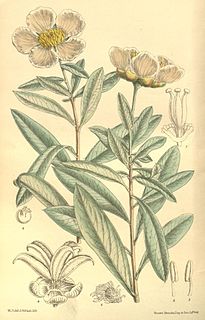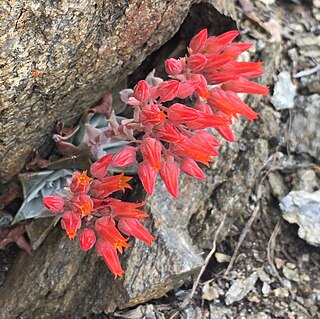
Chiricahua is a band of Apache Native Americans.

Cochise was leader of the Chihuicahui local group of the Chokonen and principal nantan of the Chokonen band of the Chiricahua Apache. A key war leader during the Apache Wars, he led an uprising that began in 1861 and persisted until a peace treaty was negotiated in 1872. Cochise County is named after him.
The Apache are a group of culturally related Native American tribes in the Southwestern United States, which include the Chiricahua, Jicarilla, Lipan, Mescalero, Mimbreño, Ndendahe, Salinero, Plains and Western Apache. Distant cousins of the Apache are the Navajo, with whom they share the Southern Athabaskan languages. There are Apache communities in Oklahoma and Texas, and reservations in Arizona and New Mexico. Apache people have moved throughout the United States and elsewhere, including urban centers. The Apache Nations are politically autonomous, speak several different languages, and have distinct cultures.

Robinia neomexicana, the New Mexican, New Mexico, Southwest, desert, pink, or rose locust), is a shrub or small tree in the subfamily Faboideae of the family Fabaceae.

Chilopsis is a monotypic genus of flowering plants containing the single species Chilopsis linearis. It is known commonly as desert willow or desert-willow because of its willow-like leaves, but it is not a true willow – being instead a member of the catalpa family.

Crossosomataceae is a small plant family, consisting of four genera of shrubs found only in the dry parts of the American southwest and Mexico. This family has included up to ten species in the past, although as of 2015 eight species are recognised. Crossosoma are shrub-like plants which can vary from being 50 cm to 5 meters tall, with small alternating leaves that surround the stem, or leaves clustered in small spurts (fascicles). Apacheria, however, has opposite leaves. Crossosoma has usually white flowers that are generally bisexual and have 5 petals attached to a nectary disk, but in Velascoa the flowers are campanulate and have an extremely reduced nectary disk.

Alisma lanceolatum is a species of aquatic plant in the water plantain family known by the common names lanceleaf water plantain and narrow-leaved water plantain. It is widespread across Europe, North Africa and temperate Asia. It is naturalized in Australia, New Zealand, Oregon, California and British Columbia. It is considered a noxious weed in some places.

Argyrochosma jonesii, known as Jones' false cloak fern, is a species of fern native to the southwestern United States and Sonora, Mexico. It grows on calcareous rocks, and has small, finely-divided leaves with a leathery texture and dark axes connecting the leaf segments. Unlike many members of Argyrochosma, it does not secrete white powder on the underside of its leaves. First described as a species in 1917, it was transferred to the new genus Argyrochosma in 1987, recognizing their distinctness from the "cloak ferns".

Crossosoma californicum, known by the common name California rockflower, is one of only a few species in the flowering plant family Crossosomataceae.

Glossopetalon spinescens is a species of flowering shrub in the family Crossosomataceae known by the common names spiny greasebush, spiny greasewood and Nevada greasewood.

Lilium parryi, common name lemon lily, is a rare species of lily.

Bursera fagaroides is a species of flowering plant in the genus Bursera known by the common names torchwood copal and fragrant bursera. It is widespread across much of Mexico from Sonora to Oaxaca, and its range extends just into Arizona in the United States, although some sources suggest that it may now be extirpated in Arizona.

Pilostyles thurberi is a species of endoparasitic flowering plant known by the common names Thurber's stemsucker and Thurber's pilostyles. It is native to the southwestern United States and northern Mexico, where it grows in desert and woodland. In the United States, P. thurberi has been recorded from the states of Arizona, California, New Mexico, Nevada, Texas.

Quercus arizonica, the Arizona white oak, is a North American tree species in the beech family. It is found in Arizona, New Mexico, western Texas, Sonora, Chihuahua, Coahuila, Sinaloa, and Durango.
Pectis imberbis is a species of flowering plant in the aster family, Asteraceae. It is native to Chihuahua and Sonora in Mexico and Arizona in the United States. It is known by the common names beardless chinchweed, beardless fetid-marigold, hierba de venado, and tall chinchweed.

Ipomoea lacunosa, the whitestar, white morning-glory or pitted morningglory, is a species that belongs to the genus Ipomoea. In this genus most members are commonly referred to as "morning glories". The name for the genus, Ipomoea, has root in the Greek words ips and homoios, which translates to worm-like. This is a reference to the plant's vine-like growth. Lacunosa comes from a Latin word meaning air spaces, correlating with the venation of the leaves. Ipomoea lacunosa is native to the United States and grows annually. The flowers of this species are usually white and smaller than most other morning glories.
Erigeron kuschei is a rare species of flowering plant in the aster family known by the common name Chiricahua fleabane. It is endemic to Arizona in the southwestern United States, where it is known from two locations in the Chiricahua Mountains.
Chrysothamnus molestus is a species of flowering plant in the aster family known by the common names Arizona rabbitbrush, Tusayan rabbitbrush, disturbed rabbitbrush, and stickyfruit low rabbitbrush. It is endemic to the State of Arizona in the southwestern United States, where it is known from Coconino, Apache, and Navajo Counties.
Heuchera eastwoodiae is a species of flowering plant in the saxifrage family, Saxifragaceae. It is endemic to Arizona in the United States, where it is found in Gila, Maricopa and Yavapai Counties. It is known by the common names Senator Mine alumroot and Eastwood alumroot.

Dudleya cymosasubsp. pumila, most commonly known as the low canyon dudleya, chalky canyon dudleya or California live-forever, is a species of perennial succulent plant. It has diamond to spoon shaped leaves, sometimes coated with a fine white powder, and in May through July, bright red, orange or yellow flowers adorn the short inflorescence. A leaf succulent primarily found growing in rocky cliffs and slopes, it is endemic to California, and grows in the Transverse Ranges and South Coast Ranges, with some outlying populations. A variable plant, in some localities it is difficult to distinguish from other plants in the genus.
















